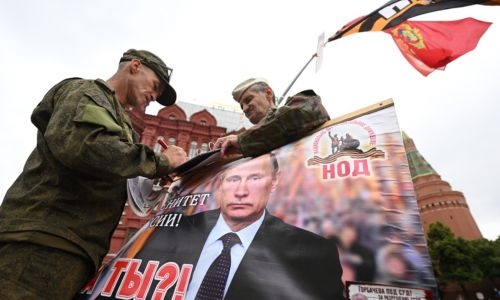Key events in the Russia-Ukraine war
AFP | Paris
The Daily Tribune – www.newsofbahrain.com
From the Russian invasion of Ukraine on February 24 last year to the armed rebellion Saturday of the pro-Kremlin Wagner paramilitary group, here is a timeline of the main events.
The biggest attack on a European country since World War II has killed or wounded over 150,000 people, according to Western estimates.
- February 2022: invasion -
Russian President Vladimir Putin announces a "special military operation" in Ukraine on February 24, saying he wants to demilitarise and "de-Nazify" the country as well as protect the predominantly Russian-speaking east from "genocide".
A full-scale invasion starts, with missile strikes on several Ukrainian cities that sparks a refugee crisis.
Ukrainian President Volodymyr Zelensky stays in the capital Kyiv to lead the resistance.
The West imposes unprecedented sanctions on Russia and the European Union and United States send Ukraine weapons and aid.
- March: Russian advances -
Russian forces make gains in the south, seizing the city of Kherson, close to the Moscow-annexed Crimea peninsula.
Russian forces also attempt to surround Kyiv and take Ukraine's second city of Kharkiv in the northeast but meet fierce resistance.
A month into the fighting, Russia withdraws from the north to focus on the eastern industrial Donbas region, partly held by Moscow-backed separatists, along with the south.
- April: war crimes revealed -
In early April, AFP discovers the bodies of at least 20 civilians lying on a single street in the Kyiv suburb of Bucha -- the first of several grisly discoveries in towns that Russian forces had occupied which spark an international outcry and war crimes investigations.
- May: Mariupol falls -
On May 21, Russia announces the fall of the southeastern port city of Mariupol, which had been relentlessly bombed, after the last Ukrainian troops holding out at a steelworks surrender.
Sweden and Finland request membership of NATO, fearing they could be future targets of Russian aggression.
- June: Donbas battle rages -
In June, Russia takes the Donbas city of Severodonetsk after one of the bloodiest battles of the war, followed soon after by the neighbouring city of Lysychansk.
- July: gas supplies cut -
On July 22, Kyiv and Moscow sign a deal to resume grain exports from Ukraine, in a bid to relieve a food crisis aggravated by Russia's blockade of the country's ports.
Russian gas giant Gazprom slashes its supply to Europe through the Nord Stream pipeline, fuelling fears of gas shortages in Europe.
- August: battle for Bakhmut -
Kyiv launches a major offensive to retake Kherson as a bitter battle begins for the eastern town of Bakhmut, spearheaded on the Russian side by the Wagner mercenary group.
Wagner claims to have wrested total control of Bakhmut in May.
- September: annexation -
Ukraine retakes hundreds of towns and villages in a lightning counter-offensive around Kharkiv.
Putin launches a partial draft of 300,000 reservists, sparking an exodus of young Russian men of military age.
On September 30, he formally annexes the Ukrainian regions of Lugansk, Donetsk, Kherson and Zaporizhzhia.
- October: power supply hit -
On October 8, an explosion causes major damage to a bridge linking Crimea to the Russian mainland -- a symbol of Moscow's annexation of the peninsula.
Putin blames Ukrainian secret services for the attack.
Russian forces retaliate with a barrage of strikes on energy infrastructure in Kyiv and other cities, leaving millions without power in what becomes its new modus operandi throughout the winter.
- November: retreat from Kherson -
On November 9, Moscow orders its troops to retreat from Kherson in the face of advancing Ukrainian forces, marking a stunning defeat in one of the regions it annexed. Jubilant residents hail Ukrainian forces as liberators.
- December: Zelensky goes to Washington -
On December 22, Zelensky visits Washington on his first overseas trip since the war began. He meets President Joe Biden and addresses Congress.
- January 2023: tanks on the way -
Russia suffers its biggest single loss of life since the invasion in a Ukrainian attack on a temporary base in the eastern town of Makiivka on January 1.
Moscow says 89 soldiers were killed in the hit.
On January 25, Germany finally agrees to send Ukraine some of its powerful Leopard tanks.
The United States follows, announcing that it will provide 31 Abrams tanks. On May 19, Biden authorises the delivery of F-16 fighter jets to Kyiv.
In April, Ukraine also receives anti-missile Patriot defence systems from Washington.
- June 6: dam destroyed -
A blast at the Kakhovka dam in Russian-annexed Crimea inundates vast areas of the Kherson region, forcing thousands to flee and sparking fears of an environmental disaster.
Kyiv accuses Moscow of blowing up the dam on the Dnipro River, while Russia blames Ukraine.
- June: Ukraine counter-offensive -
A long-awaited Ukrainian counter-offensive begins, aided by the supply of Western arms, according to analysts.
Russia brands it a failure but Kyiv says it has retaken several areas.
- June 24: Wagner rebellion -
Wagner chief Yevgeny Prigozhin, leading a mutiny to bring down Moscow's top brass, says his fighters have captured the army HQ in Russia's Rostov-on-Don "without firing a single shot" and claims to have the support of locals.
Putin warns that treason against his rule threatens Russia with civil war and accuses the Wagner boss of a "stab in the back".
Related Posts

